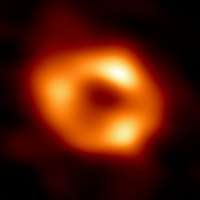
Photo from wikipedia
Black hole-neutron star (BHNS) binaries are amongst promising candidates for the joint detection of electromagnetic (EM) signals with gravitational waves (GWs) and are expected to be detected in the near… Click to show full abstract
Black hole-neutron star (BHNS) binaries are amongst promising candidates for the joint detection of electromagnetic (EM) signals with gravitational waves (GWs) and are expected to be detected in the near future. Here we study the effect of the BHNS binary parameters on the merger ejecta properties and associated EM signals. We estimate the remnant disk and unbound ejecta masses for BH mass and spin distributions motivated from the observations of transient low-mass X-ray binaries (LMXBs) and specific NS equation of state (EoS). The amount of r-process elements synthesised in BHNS mergers is estimated to be a factor of $\sim 10^{2}-10^{4}$ smaller than BNS mergers, due to the smaller dynamical ejecta and merger rates for the former. We compute the EM luminosities and light curves for the early- and late-time emissions from the ultra-relativistic jet, sub-relativistic dynamical ejecta and wind, and the mildly-relativistic cocoon for typical ejecta parameters. We then evaluate the low-latency EM follow-up rates of the GW triggers in terms of the GW detection rate $\dot{N}_{GW}$ for current telescope sensitivities and typical BHNS binary parameters to find that most of the EM counterparts are detectable for high BH spin, small BH mass and stiffer NS EoS when NS disruption is significant. Based on the relative detection rates for given binary parameters, we find the ease of EM follow-up to be: ejecta afterglow $>$ cocoon afterglow $\gtrsim$ jet prompt $>$ ejecta macronova $>$ cocoon prompt $>$ jet afterglow $>>$ wind macronova $>>$ wind afterglow.
Journal Title: Monthly Notices of the Royal Astronomical Society
Year Published: 2019
Link to full text (if available)
Share on Social Media: Sign Up to like & get
recommendations!